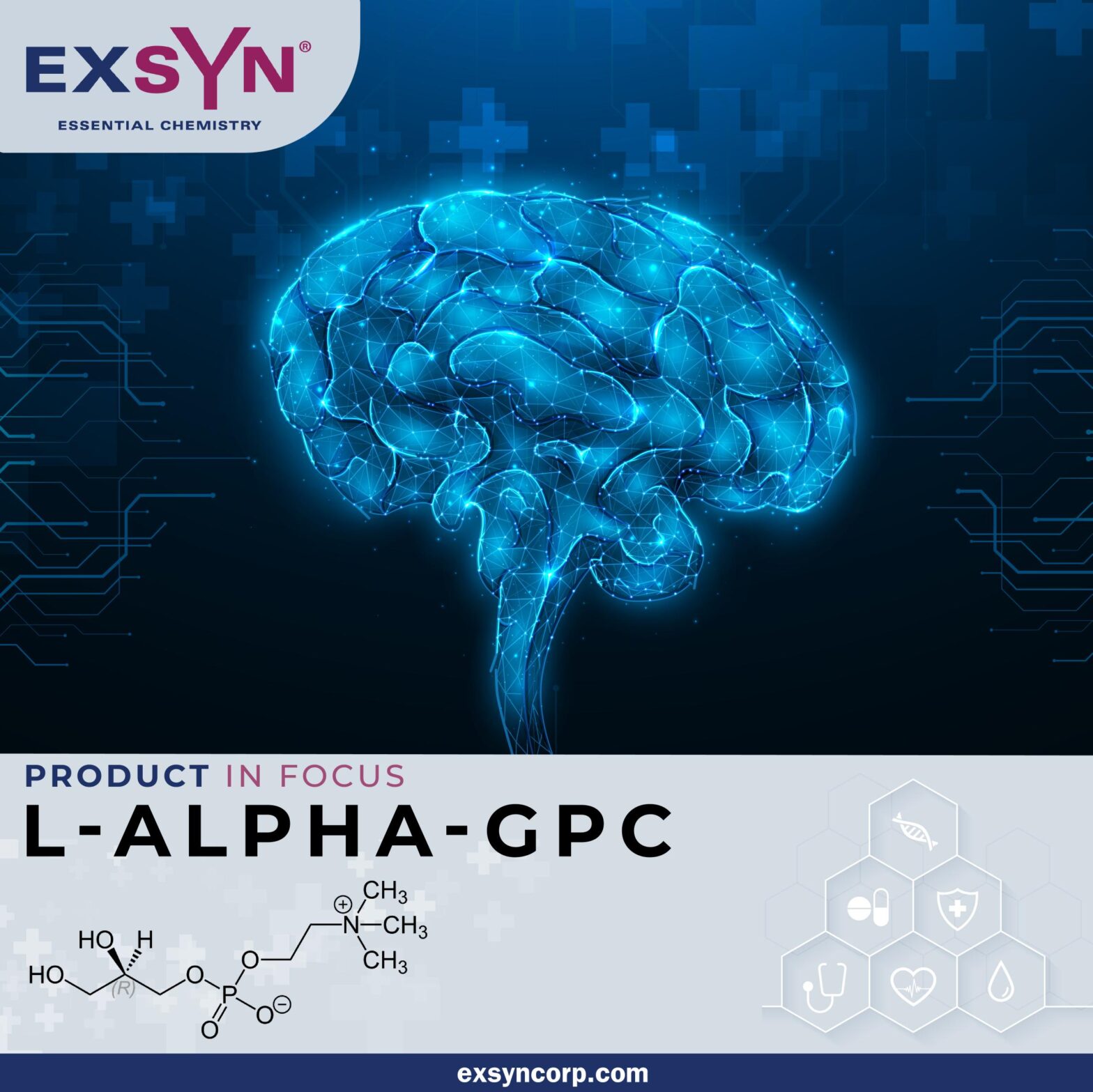INTRODUCTION
L-Alpha glycerylphosphorylcholine (alpha-GPC or choline alfoscerate) is a choline-containing phospholipid. When ingested, alpha-GPC is metabolized into choline and glycerol-1-phosphate. Choline is a precursor of acetylcholine, a neurotransmitter involved in memory, attention, and skeletal muscle contraction. Glycerol-1-phosphate is used to support cellular membranes.
Alpha-GPC appears to easily cross the blood-brain barrier and is rapidly absorbed. It is currently the best cholinergic for increasing plasma and brain choline levels.
Manufacture
Industrially, alpha-GPC is produced by the chemical or enzymatic deacylation of phosphatidylcholine enriched soya phospholipids followed by chromatographic purification. Alpha-GPC may also be derived in small amounts from highly purified soy lecithin as well as from purified sunflower lecithin.
| Synonyms | Choline glycerophosphate L-α-Phosphatidylcholine |
| CAS no. | 28319-77-9 |
| EINECS no. | 248-962-2 |
| Molecular formula | C8H20NO6P |
| Molecular weight | 257.22 |
| Structure |  |
Applications
| Alpha-GPC is a prescription medication for the treatment of Alzheimer s disease. It is available in two forms; one is taken by mouth, and the other is given as a shot. In the United States alpha-GPC is only available as a dietary supplement, mostly in products promoted to improve memory. |
| Alpha-GPC include treatment of various kinds of dementia, stroke, and “mini stroke” (transient ischemic attack, TIA). |
| Alpha GPC rapidly delivers choline to the brain across the blood–brain barrier and is a biosynthetic precursor of the acetylcholine neurotransmitter. |
SPECIFICATIONS
| Test | Unit | Specification |
|---|---|---|
| Appearance | – | White to off white hygroscopic powder |
| Identification – TLC | – | Standard solution and test solution same spot, RF |
| Specific Optical Rotation | – | -2.4° ~ 2.8° |
| Water content | % | NMT 2.00 |
| pH | – | 4.5 to 7.0 |
| Assay | % | 98.50 – 100.00 |
| Chemical Tests | ||
| Sulfate | % | NMT 0.02 |
| Chloride | % | NMT 0.02 |
| Related substance | – | Spot not bigger than standard solution spot |
| Residual solvent | % | NMT 0.5 |
| Heavy metals | ppm | NMT 10.00 |
STORAGE
Store in an airtight and light resistant container, away from moisture.
PACKING
5 kg HDPE drum.
REGISTRATION / CERTIFICATION
ISO, FSSAI, HACCP, HALAL, KOSHER & GMP certified.
No matter the quantity you need, our exceptional quality and service will make ExSyn your supplier of choice! If you need any additional information or SDS, please contact us.
Iodine is anon-metallic, dark-grey/purple-black, lustrous, solid element. It is the heaviest and the rarest of stable halogens that can be found on the crust of earth.About fifty percent of all iodine produced and manufactured worldwide is used to form Organoiodine compounds. Iodine is an important element for many health-sustaining processes and essential for human thyroid health.
The product, acronymed Oct-NBE, is an organic compound with a cyclic ring system and a 8-membered hydrophobic chain. The structure renders the chemical special properties leading to its applications in diverse fields.
Nicotine is a hygroscopic, colorless to slight yellow, oily liquid, that is readily soluble in alcohol, ether or light petroleum. It is widely used recreationally as a stimulant and anxiolytic.
The product, acronymed ETD, is an organic compound with a fused bicyclic ring system and an ethylidene group. The structure renders the chemical special properties leading to its applications in diverse fields.
Sodium perchlorate monohydrate is the inorganic compound with the chemical formula NaClO4•H2O. It is the common existence form of sodium perchlorate, which can gradually absorb water in the air to form the monohydrate. Sodium perchlorate monohydrate is white rhombic crystal which is highly soluble in water and in alcohol. Its capacity to undergo redox reactions, liberating oxygen atoms, has been harnessed in the preparation of specialty chemicals, including pharmaceutical intermediates and fine chemicals.
Triphenylphosphine is a common organophosphorus compound that is frequently abbreviated as PPh3 or Ph3P. It is widely used in organic and organometallic compound synthesis because it is an effective reducing agent as well as a neutral ligand. At room temperature, PPh3 crystals are relatively air-stable and colourless.
Potassium chlorate holds significant importance across various industries due to its diverse applications. This white crystalline compound has been utilized for centuries as an essential ingredient in the production of matches, fireworks, and explosives, owing to its ability to release oxygen upon decomposition.
Podophyllotoxin is a non-alkaloid toxin lignan extracted from the roots and rhizomes of Podophyllum species. It is an organic heterotetracyclic compound that has a Furonaphthodioxole skeleton bearing a 3,4,5-trimethoxyphenyl substituent.
Octadecylphosphonic acid (ODPA), a versatile chemical compound, serves as a surfactant and dispersant in applications spanning coatings, lubricants, and corrosion inhibition. With its hydrophobic octadecyl chain linked to a phosphonic acid group, it excels in surface modification, boosting adhesion in metal surfaces.
